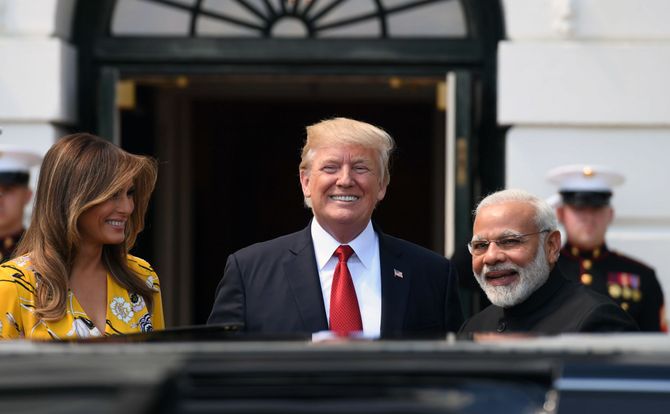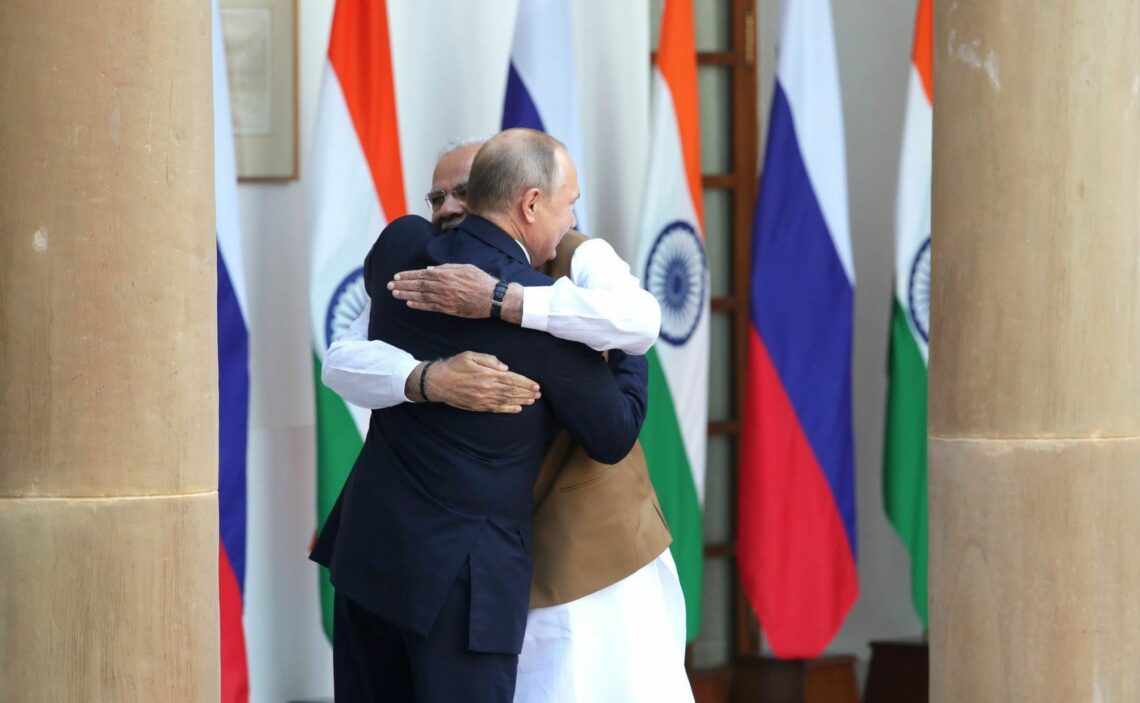U.S.-India ties are still strengthening
India imports oil from Iran and buys arms from Russia while trying to mend fences with Beijing. All this seems anathema to American policy, and now President Donald Trump has turned down an invitation to visit India in January. But reports that the relationship between the U.S. and India is on the rocks are premature.

In a nutshell
- The United States and India have significant disagreements
- Yet bigger issues, especially the rise of China, bind their interests
- Washington will probably overlook some points of dispute
- The relationship seems destined to grow stronger, not weaker
In late October, it was reported that President Donald Trump had turned down an invitation by Indian Prime Minister Narendra Modi to participate in India’s Republic Day celebrations in January 2019. This news came on the heels of uncertainty about how India would respond to calls from the United States to ban Iranian oil imports.
Furthermore, Prime Minister Modi recently held a high-profile summit with Russian President Vladimir Putin, where the leaders agreed on major new arms purchases. New Delhi and Beijing have been signaling that they want improved relations, even with the U.S. increasingly at odds with China. All this policy friction has led to speculation that the growing Indo-American strategic partnership is in trouble. That is unlikely.
Invitation and tensions
President Trump last visited India as a private businessman in 2014, when Prime Minister Modi had been in office barely four months. The two have met and spoken often since then, building on the progress made in bilateral relations during both the Bush and Obama administrations. This past summer, Mr. Modi invited Mr. Trump to attend his country’s Republic Day ceremony. While the White House did not respond, all the signals were that the U.S. president would make the trip to New Delhi.
“President Trump does look forward to visiting India, again to reflect on what has been an amazingly positive trajectory in our relationship,” declared Alice Wells, a deputy assistant secretary for South and Central Asian Affairs, in a September interview. Likewise, Indian government officials indicated they anticipated President Trump would accept the invitation. Speculation was the U.S. was waiting to see the results of the 2+2 talks between U.S. and Indian defense and foreign secretaries before responding. The talks took place in September. They were highly successful. Still, President Trump was not forthcoming about future visits to India.
Indian officials have major reservations about U.S. peace talks with the Taliban.
In October, according to reports, the White House sent a letter declining Prime Minister Modi’s invitation, claiming the president’s agenda of domestic activities precluded his attendance. This was privately confirmed by U.S. officials. The response comes at a time when several issues were tugging at the bilateral ties.
Despite warming relations, Washington and New Delhi have their differences. U.S. sanctions on Iranian oil exports – a result of President Trump ending American participation in the Iran nuclear deal (officially the Joint Comprehensive Plan of Action or JCPOA) – went into effect on November 5. India is a major importer of Iranian oil. This summer, a U.S. team went to New Delhi to brief the government on the implementation plan and seek significant reductions in Indian imports. India agreed to reduce its dependence on Iranian oil, but not to cut off imports completely, since it relies on Iran for more than 82 percent of its crude. Gasoline and diesel prices in India are rocketing as the country heads for national elections early next year. Apart from energy, India and the U.S. have also sparred over immigration, tariffs and trade policy.
There are also concerns in New Delhi that American support for Afghanistan is wavering and that if the U.S. walks away, it will mean more trouble for India. Indian experts and officials continue to have major reservations about U.S. peace talks with the Taliban.
Another contentious issue is Indian-Russian relations. India has reaffirmed its intent to purchase the Russian-built S-400 air defense system over American objections. If it goes through with the deal, it faces possible sanctions under U.S. law.

Meanwhile, Prime Minister Modi has indicated that his government intends to preserve its “strategic autonomy,” not just by maintaining cordial relations with Moscow, but also by seeking more common ground with China. “I do see a great strategic sense in improving the relationship,” Subrahmanyam Jaishankar, the former foreign secretary who remains close to the Modi government, declared at a high-profile conference in China. “Today in a much more multipolar world where everybody is playing everybody, it is not in India’s interest that our relationship with one big pole of the world is particularly bad,” he added.
Significantly, this rapprochement came just when the U.S. was becoming more confrontational with China over the South China Sea and Taiwan, and threatening Beijing with a new round of tariffs.
Some argue that these differences spell trouble for the bilateral relationship. “Indian foreign policy is passing through a period of adjustment and the India-U.S. relationship has lost some of its verve,” another former Indian diplomat, M.K. Bhadrakumar, pointed out in early September. These comments were made even before President Trump turned down the invitation to New Delhi. Now, some bluntly assert that Prime Minister Modi has lost face, investing in the relationship only to be stood up by the White House.
Setting differences aside
Privately, U.S. officials insist President Trump is not missing the parade because Washington wants to send a message to New Delhi. They are content with the trajectory of bilateral relations and say the two leaders will find another time to get together. This sounds right. None of the policy differences between the U.S. and India spell real trouble.
The U.S. and India have long agreed to set aside their differences in dealing with the Iranian regime. India has already cut oil imports from that country by roughly 30 percent, hoping to avoid a new wave of U.S. sanctions, emulating its previous strategy for avoiding oil sanctions back in 2011. It is unclear how much lower they can or will go. The U.S. recognizes India must give priority to domestic challenges: general elections will be held by April 2019 and gas pump prices are high after the government reduced subsidies for gasoline. It is unlikely that Washington will push for much more.
The U.S. knows India will maintain its relationship with Moscow, but India-Russia ties are not what they used to be.
Likewise, the U.S. has long recognized that India will maintain its relationship with Moscow. In any case, India-Russia ties are not what they used to be. New Delhi is concerned about Russia growing closer to China and its new outreach to Pakistan, while Moscow resents the growing India-U.S. partnership. Nevertheless, India’s armed forces still rely on Russia as a major supplier of defense equipment, including new platforms and spare parts/maintenance for legacy systems.
Unless President Trump issues a presidential waiver, India’s pending purchase of Russian S-400 missile defense systems risks triggering sanctions under the Countering America’s Adversaries Through Sanctions Act (CAATSA). However, neither side seems to be panicking about the issue just yet. Most Republican offices on Capitol Hill support a waiver, and Congress has already established the legal provisions for it. President Trump has not yet indicated whether he will use the waiver for India, but it is unlikely the issue will come to head before the Indian national elections.
Meanwhile, Washington appears to be trying to leverage its constructive relationship with New Delhi in trade talks on several issues, including data localization, energy, civil aviation and defense. From the American perspective, the ball is in India’s court. The U.S. does not want to sour relations by issuing a deliberate and public snub to Prime Minister Modi from the White House.
Moreover, what binds the U.S. and India together is the “bigger game”: dealing with the destabilizing rise of China. India strongly supports the Trump administration’s Free and Open Indo-Pacific Strategy. There is a growing political consensus in India that without a forward-leaning American presence, Asia will be less free, less open and more authoritarian. One former Indian ambassador recently even suggested that the U.S. and India “should be considering mutual security guarantees.” That sentiment used to be unthinkable among Indian strategists.
Rather than following the Japanese approach of using a more muscular American presence in Asia to balance growing Chinese power, the Indians seem to be employing it to extract concessions from Beijing. Many experts affiliated with the ruling Bharatiya Janata Party (BJP) praise the Trump administration’s firmer approach to China and believe that New Delhi has been reaping the benefits of this new pressure. They note that China has adopted a much more conciliatory tone toward India in recent months. New Delhi senses that Beijing was thrown off guard by the Trump administration’s more confrontational approach.
After India’s elections, one should expect progress on a fighter aircraft deal with the U.S.
The Indian government has also become more sanguine about the U.S. strategy in Afghanistan. Ramping up the diplomatic initiative with the Taliban is not a signal that Washington is abandoning its efforts in support of the Afghan government. The U.S. is pairing a diplomatic effort under its most experienced and respected interlocutor, Zalmay Mamozy Khalilzad, with military and other support.
Finally, the Indians are pleased with the U.S. position on Pakistan. Indian officials have praised the Trump administration’s more hard-line approach to Islamabad.
Scenarios
The most likely scenario is that the U.S.-Indian relationship will continue to improve steadily. After signing two foundational military agreements with India over the past two years, it seems likely Washington and New Delhi will come to terms on the final deal, a Basic Exchange and Cooperation Agreement (BECA), in the next year. A BECA would facilitate the exchange of geospatial information. In addition, expect another meeting of the two leaders next year and continued cooperation on policies toward Afghanistan, Pakistan and China.
There will also be more defense cooperation. After India’s elections, one should expect progress on a fighter aircraft deal, regardless of how the dispute over the S-400 is resolved. India will also probably become more engaged in the Middle East, supporting policies that align better with U.S. interests. Finally, while India will maintain constructive relations with both Iran and Russia, neither relationship will hinder its growing strategic partnership with the U.S.






